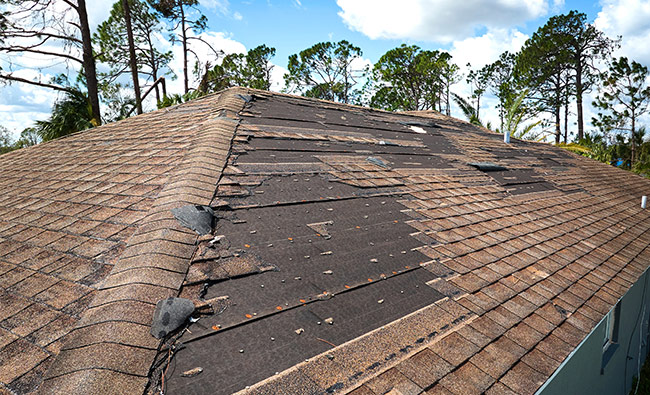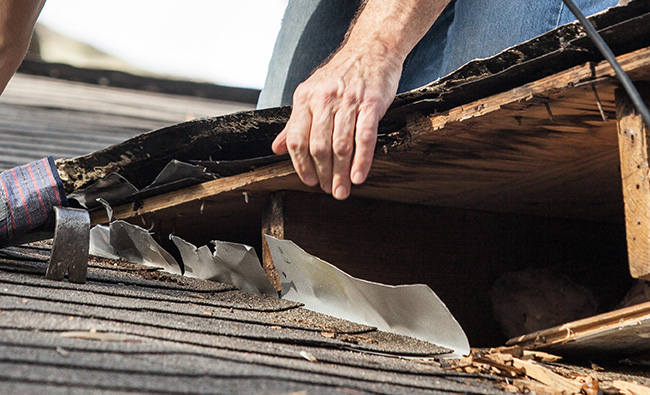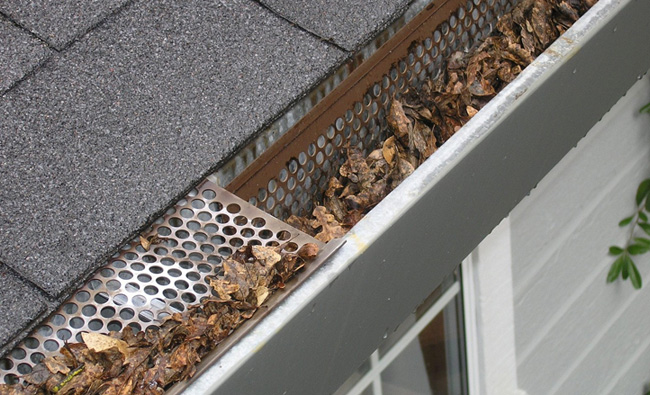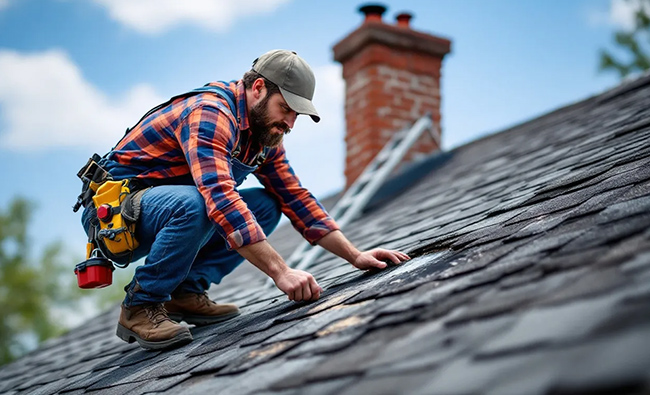
Key Takeaways
- Address roof leaks promptly to prevent structural damage and perform regular maintenance to extend the roof’s lifespan.
- Detect and replace damaged shingles immediately to maintain roof integrity and avoid further issues, especially in storm-prone areas.
- Regular gutter maintenance and proper ventilation are essential in preventing water accumulation and moisture-related problems, which can compromise roofing materials.
Roof Leaks and How to Address Them
Roof leaks rank as one of the most prevalent issues for homeowners. They are a significant concern when it comes to roofing problems. A variety of factors can cause these issues. Examples include damaged flashing, missing shingles, and clogged gutters. Addressing roof leaks promptly is crucial to prevent further damage and preserve the structural integrity of your home.
Signs of a roof leak can often be identified through water stains on ceilings and walls or the presence of mold around the house. If you notice these signs, it’s crucial to locate the source of the leak. Start by inspecting common problem areas, such as around chimneys, skylights, and vents. Minor roof repairs can often be handled by resealing these areas or replacing damaged shingles.
For more severe roof repairs, such as significant water damage or structural issues, it’s best to call in a professional roofing contractor. Emergency roof repairs may be necessary if the leak poses an immediate threat to your home’s safety. Regular roof inspections and maintenance can help prevent leaks from occurring in the first place, ensuring your roof repair remains in good condition.
Preventing costly repairs is easier than you might think. Regular roof maintenance can significantly extend the life of your roof, such as cleaning gutters and checking for potential problem areas. Prompt attention to minor repairs helps avoid more severe issues and keeps your home safe and dry.
1. Damaged Shingles

Damaged shingles are another common roofing issue that can lead to significant problems if not addressed. Routine roof inspections can help detect issues like cracked, warped, or missing shingles. Visible signs of shingle damage include dark stains, which could indicate the presence of moss or algae.
Shingles can be damaged by high winds, fallen trees, flying debris, or animals. Promptly replacing broken shingles maintains the roof’s integrity and prevents more extensive damage. If you live in a storm-prone area, replacing roof shingles immediately after a storm is critical to avoid further issues.
While replacing damaged shingles, you might face challenges such as finding an exact color match due to sun bleaching. A local roofing contractor can assist with replacing damaged shingles and ensuring a proper match. Prompt shingle repairs prevent structural damage and extend your roof’s lifespan.
2. Damaged Flashing

Flashing directs water away from critical areas on the roof, such as chimneys, vents, and skylights. Damaged flashing can lead to roof leaks and structural issues if not addressed promptly. Common signs of flashing damage include cracked seals, visible gaps, corrosion, water stains, and mold.
Repairing damaged flashing often involves resealing or replacing it to restore functionality. Improper installation can cause flashing to fail, leading to water flowing underneath the roofing materials and causing further damage. Regularly checking and fixing flashing issues is essential to ensure the roof’s integrity.
Noticing damaged flashing should prompt a call to a professional roofing contractor for assessment and repair. Timely repairs can prevent further damage and keep your roof in good condition. Maintaining your flashing helps avoid costly repairs and extends your roof’s lifespan.
3. Gutter Maintenance and Repair
Gutters play a vital role in your home’s roofing system by directing rainwater away from the house. They eliminate water accumulation from the roofline, directing it away from the home. Clogged gutters can worsen roof problems by leading to water overflow and potential damage to fascia boards, walls, and foundations.
Common problems that arise from clogged gutters include leaks, rot, and structural damage. Regular cleaning of gutters is necessary to prevent water backup that can damage shingles and other roofing materials. Gutters should be cleaned at least twice yearly, ideally in spring and fall, to prevent issues caused by accumulated debris.

If your gutters overflow despite being clean, inspect for possible gutter damage and improper slope. Regular maintenance and timely repairs are essential to avoid expensive problems and ensure that your gutters are functioning efficiently.. Maintaining your roof drainage system and gutters protects your roof and home from water damage.
4. Poor Ventilation Issues
Poor ventilation can lead to significant issues like moisture accumulation, which affects the integrity of roofing materials and overall roof health. Effects of poor attic ventilation include excessive heat buildup, which can cause roofing materials to age prematurely and increase energy costs.
Proper airflow in the attic improves ventilation. This helps reduce the risk of moisture accumulation and prevents mold growth.
If issues related to ventilation are identified, it is vital to hire a licensed contractor to investigate and implement necessary repairs for effective airflow. Maintaining a healthy roof and preventing costly repairs requires proper ventilation.
5. Ponding Water on Flat Roofs
Standing water on flat roofs, commonly called ponding water, can be caused by various factors, including inadequate drainage and structural issues. Ponding water should not remain on flat roofs for more than 48 hours to prevent damage to the roof structure and materials.
Clogged drains are a common cause of ponding water on flat roofs, leading to potential leaks and damage if not addressed. Installing additional drains can alleviate pooling water issues, especially near parapet walls. Silicone-based roof coatings are effective for areas experiencing ponding water when applied correctly.
In some cases, re-pitching or overlaying the roof with a new membrane might be necessary to address ponding issues and aged roofing material. If other repair methods are ineffective, a complete roof replacement might be required. Promptly addressing ponding water prevents significant damage and extends the life of your flat roof repairs.
6. Emergency Roof Repairs

When water, fire, wind, or tree damage occurs, emergency roof repairs are necessary. Signs of an emergency include visible water leaks, large puddles on the roof, or major structural threats. Swift action and informed decisions are crucial during a roofing emergency to minimize damage.
During a roofing emergency, the first step is to contact a local roofing contractor. They will be able to assist you with the situation. Temporary tarping can be used to minimize damage until a professional can perform repairs. Documenting damage and taking photos can facilitate a smoother insurance claims process.
Immediate attention to ice dams on a roof is necessary to avoid water damage. Prompt emergency repairs prevent further damage and ensure your home’s safety. Always be prepared and know when to seek professional help to handle roofing emergencies effectively.
7. Preventive Maintenance Repairs
Regular inspections of the roof are essential. They help identify issues such as missing granules, cracks, and leaks. Scheduling at least one roof inspection per year can help identify potential problems early. Proper gutter maintenance, such as ensuring downspouts are connected, can prevent water from pooling on the roof.
Trimming trees and branches that are near the entire roof can prevent damage caused by falling limbs or abrasion. Preventive measures like timely repairs and maintenance can significantly prolong roof life and prevent costly repairs.
Proactive steps help maintain a healthy roof and avoid unexpected issues.
Choosing the Right Roofing Contractor
Choosing the right roofing contractor ensures quality work and protects your investment. Homeowners should check roofing contractors’ credentials to confirm a valid license and insurance. References from previous clients can offer insights into a contractor’s reliability and quality of work.

Obtaining multiple written estimates from roofing contractors allows for comparison of prices and services offered. Comparing quotes helps ensure competitive pricing and service evaluation for roof projects. Understanding the difference between a contractor’s workmanship warranty and the manufacturer’s warranty is crucial for long-term satisfaction.
Contractors that offer financing options may indicate financial stability and professionalism. A trustworthy contractor should provide a clear plan for their work and explain how the roofing system functions. Choosing the right contractor ensures your roofing project is completed to the highest standard.
Roof Repairs Summary
In conclusion, maintaining your roof is essential for the safety and longevity of your home. From fixing roof leaks and damaged shingles to handling poor ventilation and emergency repairs, addressing these issues with urgency can prevent costly repairs and prolong the life of your roof.
Regular inspections, preventive maintenance, and choosing the right roofing contractor are key to ensuring your roof remains in good condition. By taking proactive steps, you can protect your home and enjoy peace of mind knowing your roof is well-maintained.
Common Roof Repairs Frequently Asked Questions
What are the most common causes of roof leaks?
The most common causes of roof leaks are damaged flashing, missing shingles, and clogged gutters. Regular inspections and maintenance can help prevent these issues.
How can I identify damaged shingles?
To identify damaged shingles, look for visible signs such as dark stains, cracks, warping, or missing shingles. Addressing these issues as soon as you notice them can help prevent further damage to your roof.
What should I do if I notice damaged flashing?
If you notice damaged flashing, promptly call a professional roofing contractor for assessment and repair to prevent further damage. Taking this action can help safeguard your property from potential leaks and structural issues.
How often should gutters be cleaned?
Gutters should be cleaned at least twice a year, ideally in spring and fall, to prevent issues from debris buildup. Regular maintenance will help ensure proper drainage and avoid costly repairs.
Why is poor ventilation a problem for roofs?
Poor ventilation is a significant problem for roofs because it causes moisture buildup and excess heat, which can lead to premature aging of roofing materials. Ensuring proper ventilation is crucial for maintaining the integrity and lifespan of your roof.
(352) 293-2449